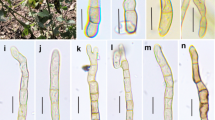Abstract
The genusHampea Schlecht. is included in the Malvaceae, tribe Gossypieae, rather than in the Bombacaceae where it was originally placed. Discussion includes the morphology, geography (central Mexico to western Colombia), reproductive cycle, utilization and vernacular names, and cytology (n = 13) of the genus. Three species have perfect flowers; the remainder are dioecious. The 16 species (and one variety) that are accepted are divided into three sections, one of which is further subdivided into three series. The following taxa are described as new:H. nutricia, H. mexicana, H. sphaerocarpa, andH. appendiculata var.longicalyx.
Similar content being viewed by others
Literature Cited
Aguilar G., J. I. 1958.Hampea. p. 124.In: Relatión de Unos Aspectos de la Flora Útil de Guatemala. Guatemala: Imprenta Hispania.
Allen, P. H. 1956. The Rain Forests of Golfo Dulce. Gainesville, Florida: Univ. Florida Press. 417 pp. (cf.Hampea, pp. 218, 219).
Berlin, B., D. E. Breedlove, &P. H. Raven. 1966. Folk taxonomies and biological classification. Science154: 273–275.
Cook, O. F. &R. C. Cook. 1918. The Maho or Mahaqua [Hibiscus tiliaceus] as a trans-Pacific plant. Jour. Washington Acad. Sci.8: 153–170.
Corner, E. J. H. 1949. The Durian Theory or the origin of the modern tree. Ann. Bot. (London) n.s.13: 367–414.
—. 1953. The Durian Theory extended. I. Phytomorphology [Delhi]3: 465–476.
—. 1954. The Durian Theory extended. II. The arillate fruit and the compound leaf. Phytomorphology [Delhi]4: 152–165.
Cuatrecasas, J. 1954. Disertaciones sobre Bombacaceas. Revista Acad. Colombiana Ciencias Exactas9: 164–177.
Fryxell, P. A. 1968. A redefinition of the tribe Gossypieae. Bot. Gaz.129: 296–308.
—, &M. J. Lukefahr. 1967.Hampea Schlecht.: Possible primary host of the cotton boll weevil. Science155: 1568, 1569.
Jacobs, M. 1966. On domatia: The viewpoints and some facts. Proc. Kon. Nederl. Akad. Wetensch. Ser. C. Biol. Med. Sci.69(3): 275–316.
Janda, Charlotte. 1937. Die extranuptialen Nektarien der Malvaceen. österr. Bot. Zeitschr.86: 81–130.
Lukefahr, M. J. &P. A. Fryxell. 1969. The role ofHampea sp. in the migration of the cotton leafworm to the United States. Jour. Econ. Entomol.62: 263, 264.
Lundell, C. L. 1937. The Vegetation of Petén. Carnegie Inst. Washington Publ. 478. 244 pp.
—. 1938 (1939). Plants probably utilized by the Old Empire Maya of Petén and adjacent lowlands. Papers Michigan Acad. Sci.24: 37–56.
Parkin, J. 1953. The Durian Theory—a criticism. Phytomorphology [Delhi]3: 80–88.
Pennington, T. D. &J. Sarukhán. 1968. Manual para la Identificatión de Campo de los Principales Arboles Tropicales de México. México, D. F.: Instituto National de Investigaciones Forestales. v + 413 pp.
Pijl, L.van der. 1966 (1967). Ecological aspects of fruit evolution: A functional study of dispersal organs, I, II, III. Proc. Kon. Nederl, Akad. Wetensch. Ser. C. Biol. Med. Sci.69: 597–614, 615–624, 625–640.
Purpus, C. A. 1906. Zacuapan, Huatusco, Mexiko. Gartenwelt11(3): 32, 33.
Record, S. J. 1939. American woods of the family Bombacaceae. Tropical Woods59: 1–20. (cf. pp. 13, 14).
Reko, B. P. 1919. De los nombres botánicos Aztecas. México Antiguo1: 113–157.
Robyns, A. 1964. Family 116. Bombacaceae. Flora of Panama, Part VI. Ann. Missouri Bot. Gard.51: 37–68.
Schiede, C. J. W. 1829, 1830. Botanische Berichte aus Mexico. Erster Bericht über die Vegetation um Veracruz und über die Reise von dort nach Jalapa. Linnaea4: 205–212; Zweiter Bericht über die Gegend um Jalapa und Excursion auf den Volcan de Orizaba.4: 212–236; Dritter Bericht über die Gegenden von Papantla und Misantla und über die Reise von Jalapa dorthin und zurück.4: 554–582. 1829; Vierter Bericht. Excursionen in der Gegend von Jalapa und Reise von dort nach Mexico.5: 463–477. 1830.
Schnell, R., G. Cusset, &M. Quenum. 1963. Contribution a l’étude des glandes extra-florales chez quelques groupes de plantes tropicales. Revue Gén. Bot.70: 269–342.
Selander, R. B. &Patricia Vaurie. 1962. A gazeteer to accompany the “Insecta” volumes of the “Biologia Centrali-Americana.” Amer. Mus. Novitates2099: 1–70.
Standley, P. C. 1920–1926. Trees and Shrubs of Mexico. Contr. U. S. Nat. Herb. 23. 5 pts. pp. 1–1721. (cf.Hampea, 23(3): 786,787. 1923).
—. 1927. The genusHampea. Jour. Washington Acad. Sci.17: 394–398.
—. 1930. Flora of Yucatan. Publ. Field Mus. Nat. Hist., Bot. Ser.3: 157–492. (cf.Hampea, p. 353).
—. 1931. Flora of the Lancetilla Valley, Honduras. Publ. Field Mus. Nat. Hist., Bot. Ser.10: 1–418. (cf.Hampea, p. 277).
—. 1933. The flora of Barro Colorado Island, Panama. Contr. Arnold Arb.5: 1–178. (cf.Hampea, p. 103).
—. 1937, 1938. Flora of Costa Rica. Publ. Field Mus. Nat. Hist., Bot. Ser.18: 1–1616. (cf.Hampea, pp. 680, 681. 1937).
— &S. J. Record. 1936. The forests and flora of British Honduras. Publ. Field Mus. Nat. Hist., Bot. Ser.12: 1–432. (cf.Hampea, p. 249).
—. &J. A. Steyermark. 1949. Flora of Guatemala. Fieldiana: Bot.24(6): 1–440. (cf.Hampea, pp. 393–396).
Stanford, E. E. &A. Viehoever. 1918. Chemistry and histology of the glands of the cotton plant, with notes on the occurrence of similar glands in related plants. Jour. Agric. Res.13: 419–435.
Steenis, C. G. G. J.van. 1968. Occurrence of domatia as a systematic character. Flora Malesiana Bull.22: 1568–1570.
Steyermark, J. A. 1957. Botanical exploration in Venezuela. IV. [From Algae through Spermatophyta: Families listed in Systematic Order.]In: Contributions to the Flora of Venezuela. Fieldiana: Bot.28(4): 679–1190.
Triana, J. &J. E. Planchon. 1862. Prodromus Florae Novo-granatensis. Ann. Sci. Nat. Bot. IV.17: 5–190, 319–382. (cf.Hampea, pp. 188, 189).
Watson, S. 1886. 3. Notes upon plants collected in the Department of Yzabal, Guatemala, February to April, 1885.-I. Ranunculaceae to Connaraceae. Proc. Amer. Acad. Arts Sci.21: 456–464. (cf.Hampea, pp. 460, 461).
Williams, Llewelyn. 1939. Arboles y arbustos del Istmo de Tehuantepec, México. Lilloa4: 137–171.
Wilson, F. D. 1968. Malvaceae.In: IOPB Chromosome number reports. Taxon17: 577.
Author information
Authors and Affiliations
Rights and permissions
About this article
Cite this article
Fryxell, P.A. The genus hampea(Malvaceae). Brittonia 21, 359–396 (1969). https://doi.org/10.2307/2805764
Issue Date:
DOI: https://doi.org/10.2307/2805764




